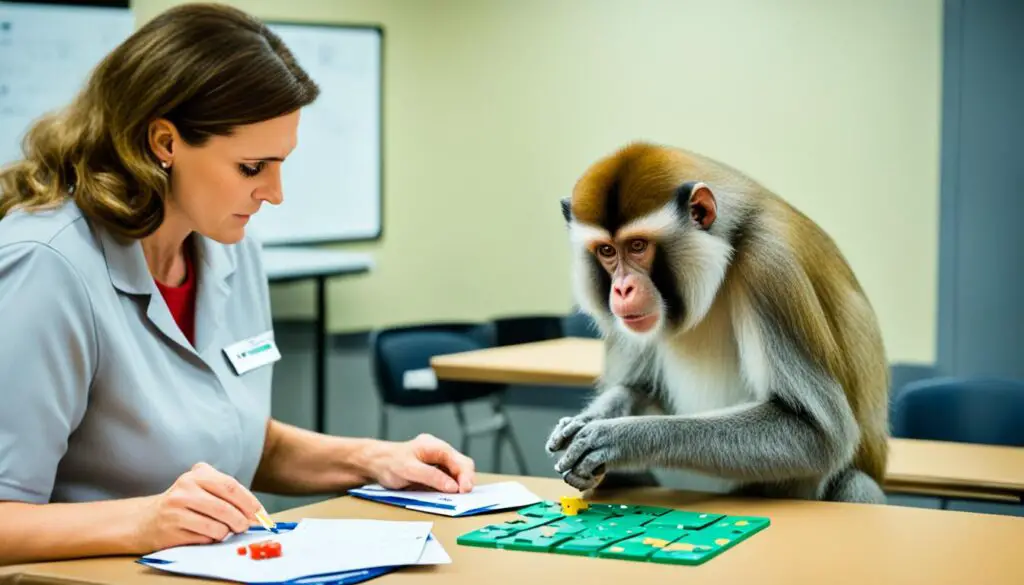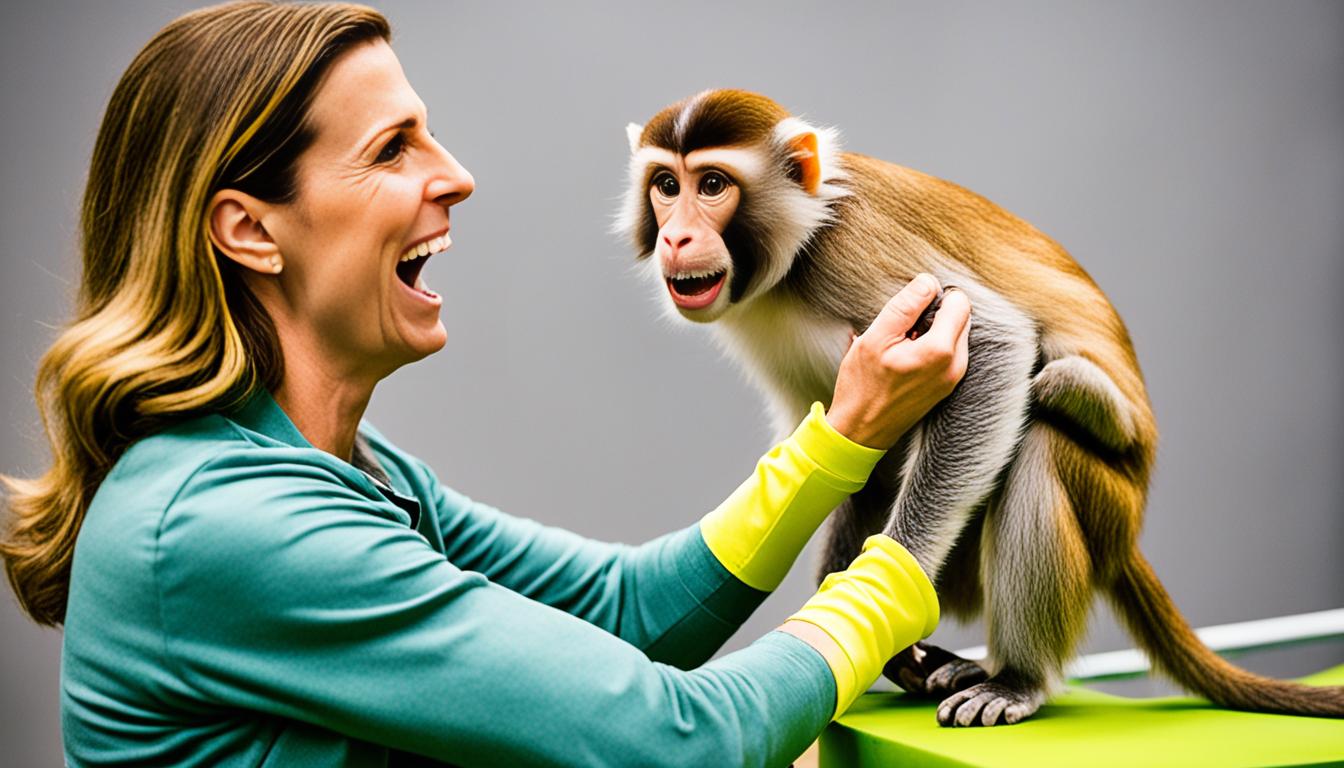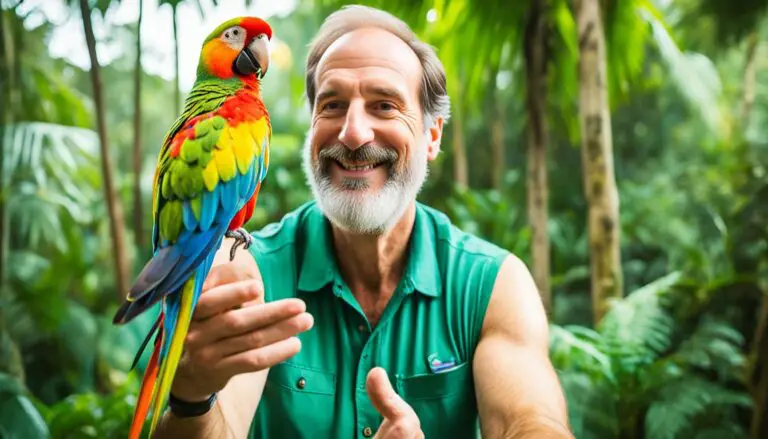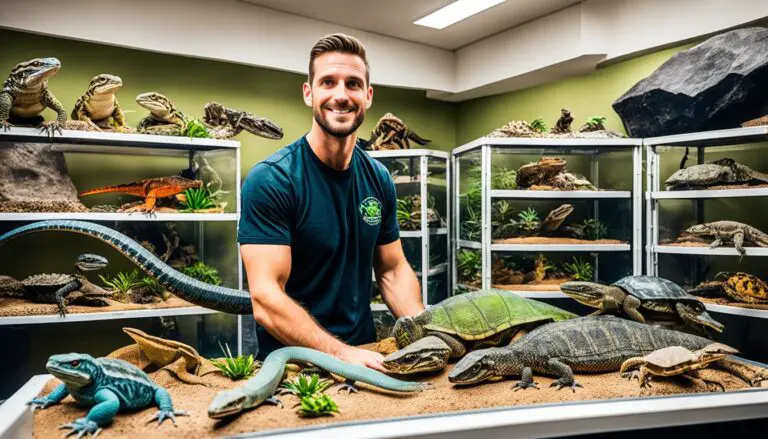Primate Training Techniques | Effective Methods
Using positive reinforcement in primate training can cut vet procedure times down by 50%. This approach makes caring for primates easier and less stressful. It does this by getting primates to join in their care. Primate animal behavior training focuses on rewards, not force. This boosts the wellbeing of captured primates by promoting working together happily. Rather than forcing them, training them to do tasks on their own smoother. This includes exams, treatments, taking samples, and managing group behaviors.
Key Takeaways
- Positive reinforcement significantly improves the welfare of captive primates.
- Effective primate training includes encouraging voluntary cooperation.
- Improved techniques streamline veterinary care and sample collection.
- Primate care strategies cover a range of behaviors from husbandry to complex medical procedures.
- Adaptive training methods enhance social group dynamics and overall quality of life.
Introduction to Primate Training Techniques
The care of primates has evolved greatly. We now have better ways to train them that are good for their bodies and their minds. These training methods aim to make it easier to care for captive primates.
Advanced training helps create a better relationship between primates and their caregivers. One key method is primate positive reinforcement training. This method trains them by rewarding good behaviors. It helps make tasks like feeding, cleaning, and health checks go smoothly.
Using positive reinforcement in primate care has many benefits. It makes the primates happier and less likely to get stressed or be aggressive. This method improves the care they receive, leading to better lives for them.
These modern training methods offer a broader approach to primate care. They help us understand primate behavior better. Ultimately, these methods enhance the well-being of the primates in our care.
The Benefits of Positive Reinforcement
Positive reinforcement is vital in how we train primates today. It’s a kind and successful way to shape their behavior. By rewarding the right actions, we help them work with us and live better lives.
Defining Positive Reinforcement
Positive reinforcement comes from a learning approach called operant conditioning. It means giving rewards to make good actions happen more. It works well with primates’ thinking. They quickly learn what brings them positive results. This helps them stay interested and eager to learn more.
Applications in Primate Training
Using positive reinforcement with primates has many benefits. It makes medical checks and tests easier. For example, collecting samples is less stressful for them. It also makes living in groups more pleasant. They start to see good behaviors lead to positive outcomes.
This method also helps them talk to us better. We can make their communication clearer by rewarding certain behaviors. This enhances the understanding between the primates and those caring for them.
Essential Primate Care Methods
Optimal primate care methods require a holistic view. This includes the right habitat, nutrition, social interaction, and watching their health. All these parts are key to creating a great environment for primates.

Using positive reinforcement techniques helps in managing their daily life. This makes their behavior better by getting them used to their care schedules. It also lowers stress-related actions. Caregivers can boost their mental health by keeping them active and engaged.
Good primate enrichment strategies make sure they have an environment that meets their needs. This includes socializing to encourage their natural actions. Giving them the right food helps keep them healthy and happy.
Here’s what you need to know for primate care:
| Aspect | Description |
|---|---|
| Habitat | Ensure an environment that mimics natural conditions, providing space and enrichment items. |
| Nutrition | Offer diets rich in variety and nutrients, tailored to species-specific requirements. |
| Social Interaction | Foster social bonds through group living setups, encouraging natural interactions. |
| Health Monitoring | Conduct regular health checks and use positive reinforcement to ease these procedures. |
By following these primate care methods, caregivers improve both the physical and mental health of primates. Using primate enrichment strategies keeps them active and healthy. This helps in making their lives better, even in captivity.
Behavioral Modification Strategies for Primates
It’s key to know how to change primate behavior for their better welfare and group harmony. Using positive reinforcement and operant conditioning helps. Caretakers can manage problems like fear and aggression well.
Approaches to Reduce Fear
To reduce fear in primates, you first find what makes them anxious. This can often be fixed with primate behavior modification. It uses slow exposure to new things and rewards calmness.
This makes primates less scared and more confident around others. By always rewarding the quiet ones, they learn peaceful behavior is good.
Managing Aggression and Competition
Tackling primate aggression needs a good grasp of their social lives. Aggression comes from fighting over stuff or who’s the boss. Experts encourage peaceful actions and turn aggressive energy to good use.
Keeping an eye on group and individual behaviors helps keep the peace. This gives everyone in the group a fair chance.
Zoos and labs use special primate behavior modification to make calmer, happier primates. They include these in daily routines to encourage better group dynamics.
Integrating Primate Enrichment Techniques
It’s vital to use smart primate enrichment techniques for captive primates’ well-being. These techniques make the environment more fun and interesting, similar to their natural habitat. They ensure the primates stay active, think a lot, and meet other primates.
Adding new items to the environment is a big part of caring for primates. These can be as simple as ropes or more challenging like puzzles. This keeps them sharp and active, encouraging activities like climbing and problem-solving.
Using primate cognitive training like memory games is also important. These activities help keep the primates’ minds busy, reducing stress and avoiding boredom.
Let’s compare different primate care strategies for better enrichment and cognitive training:
| Enrichment Technique | Description | Benefits |
|---|---|---|
| Novel Objects | Introduction of new and varied items for play. | Encourages exploration and manipulation, promoting physical exercise. |
| Foraging Puzzles | Puzzles designed to hide food, requiring problem-solving skills to access. | Enhances mental stimulation and mimics natural foraging behavior. |
| Problem-Solving Tasks | Interactive challenges that require cognitive engagement. | Improves cognitive abilities and reduces stress. |
| Social Interaction | Facilitates group activities and social play among primates. | Supports mental well-being and fosters social bonds. |
By using these primate care strategies, the life quality of primates gets better. It also makes the captive environment healthier and more engaging. A balanced mix of physical, mental, and social activities is key for their well-being and to encourage normal habits.
The Role of Cognitive Training in Primate Care
Cognitive training in primates involves activities that boost their brainpower. This includes memory games, learning symbols, and using tools. These tasks are crucial for primate cognition training, which aids behavior and mental well-being.
This kind of training has many advantages. It keeps their minds healthy and helps them deal with new situations. It is a key element in advanced primate training methods, showing the value of creative care.

| Cognitive Activity | Impact on Mental Health | Adaptability Improvement |
|---|---|---|
| Memory Games | High | Moderate |
| Symbol Learning | Moderate | High |
| Operating Devices | High | High |
Regular primate cognitive training can hugely improve the lives of these animals. It allows caretakers to create more enriching and adaptable habitats for captive primates.
Advanced Techniques for Primate Communication
Advanced methods help primates understand and respond well to trainers. They use verbal cues and clicker training. These are key for successful primate training.
Utilizing Verbal Cues
Using words is crucial in primate communication. Handlers can give clear commands this way. Cues can include simple orders like “sit” or “stay.” They also cover more complex instructions for medical checks. It’s very important to be clear and consistent with these verbal cues.
Introducing Clicker Training
Clicker training is a top method for primates. It uses a special device, a clicker, to make a sound for correct actions. This sound tells the primate a treat is coming, which reinforces the good behavior. Clicker training is popular in primate programs because it’s very precise and effective. It makes training more accurate and builds a better bond between primates and trainers.
| Technique | Features | Benefits |
|---|---|---|
| Verbal Cues | Uses clear and consistent spoken commands | Enhances understanding and response during training |
| Clicker Training | Employs a clicker to mark behaviors | Improves precision and fosters a cooperative bond |
Implementing Effective Primate Training Programs
Effective primate training is a well-rounded approach that uses different methods for each captive primate’s needs. It’s key to have a steady routine. This builds trust between the animals and those caring for them.
Training is about helping primates adjust and work together. It’s done step by step so they’re not too stressed. They learn in a way that makes them better and happier.
Primate training focuses on mixing up tasks. This keeps them interested and helps with their skills for daily life and health.
Trust and consistency are key for trainers. A set schedule makes a safe place for both the animals and the people looking after them.
| Training Component | Goal | Outcome |
|---|---|---|
| Routine Establishment | Build trust and predictability | Enhanced cooperation and reduced stress |
| Varied Tasks | Engage and stimulate primate minds | Comprehensive skill development |
| Incremental Learning | Allow gradual adaptation | Better behavioral outcomes |
These training methods are not just to tick off tasks. They help make the primates’ lives better. By following the right methods, trainers can give each primate the care they need to do well.
Training for Veterinary Procedures
It’s crucial to train primates well for vet procedures to keep them healthy. Using positive methods helps them stay calm and work with the vets willingly. This kind approach makes check-ups more accurate and saves resources too.
Handling Biologic Sample Collection
Collecting biological samples is key but can stress primates. We can teach them to take part without fear using rewards. This way, the samples stay good and the process goes smoothly.
Preparing for Medical Examinations
Medical check-ups are important for monitoring primate health. Training them to be okay with these exams is crucial. Teaching them slowly about tools and handling makes the visits faster and more effective.
Making training part of daily life, especially for samples and check-ups, boosts primate welfare. It combines kindness with good care, helping both the primates and their caregivers.
FAQ
What are the key principles behind effective primate training techniques?
Why is positive reinforcement important in primate care methods?
How can primate enrichment methods improve the life of captive primates?
What are some advanced primate training methods used in behavioral modification?
How do cognitive training activities benefit primates?
How do communication techniques play a role in primate training?
What strategies are employed to manage aggression and competition among primates?
What are the benefits of implementing structured primate training programs?
How does training facilitate effective veterinary procedures for primates?
Source Links
- https://asp.org/welfare/animal-training/
- https://www.ncbi.nlm.nih.gov/pmc/articles/PMC4311744/
- https://www.nc3rs.org.uk/sites/default/files/documents/Guidelines/Papers/Prescott & Buchanan-Smith, JAAWS special issue 2003.pdf
Peter Stones is the founder of Exotic Pets Place, the leading online resource for exotic pet care information.
With over 10 years of hands-on exotic pet ownership experience, he is deeply passionate about sharing his expertise to help others properly care for their unusual pets.
When he's not writing extensively researched articles or connecting with fellow exotic pet enthusiasts worldwide, you can find Peter at home tending to his own beloved menagerie of exotic animals.





![How to Train Your Exotic Pet to Use a Litter Box [+ Practical Tips], a fluffy puppy in a box](https://exoticpetsplace.com/wp-content/uploads/2023/05/How-to-Train-Your-Exotic-Pet-to-Use-a-Litter-Box-Practical-Tips-a-fluffy-puppy-in-a-box-768x512.jpg)

